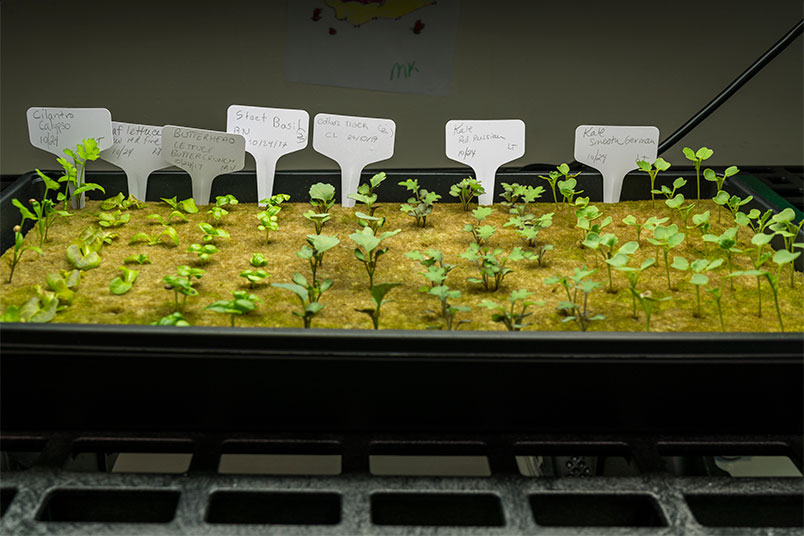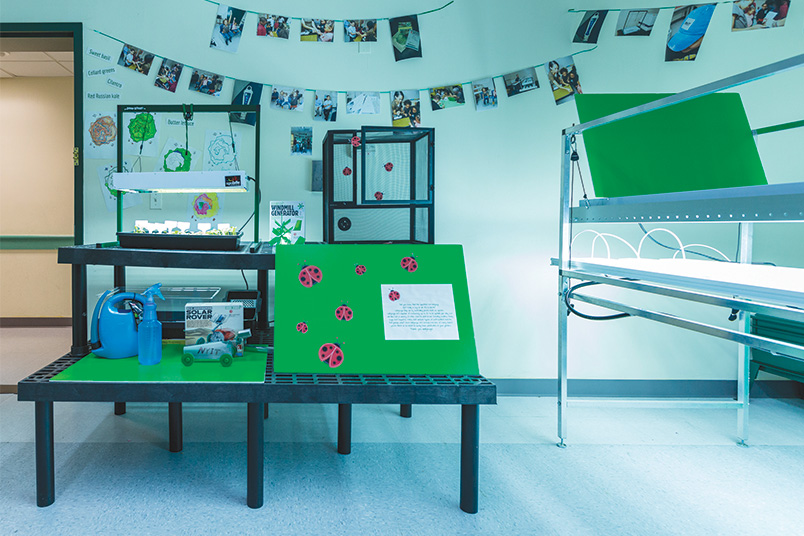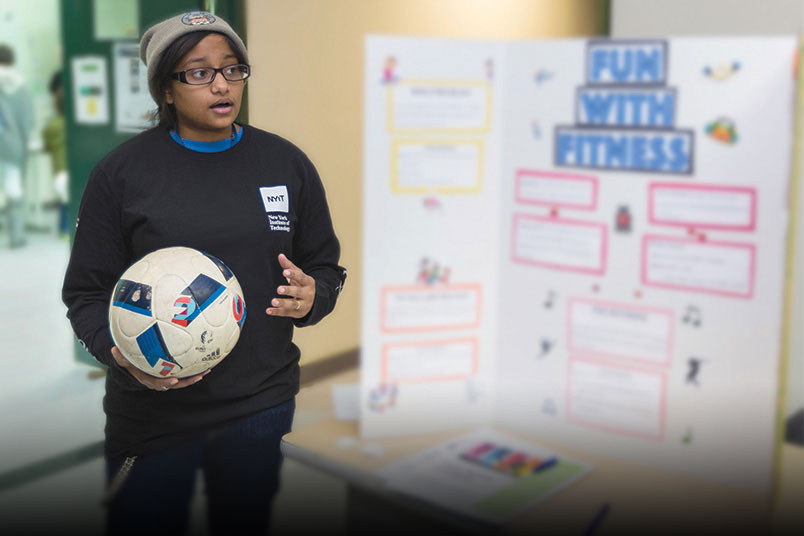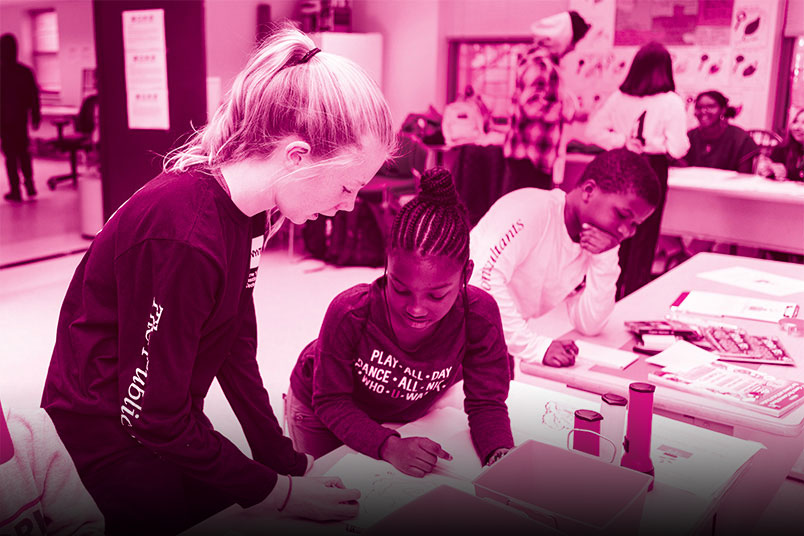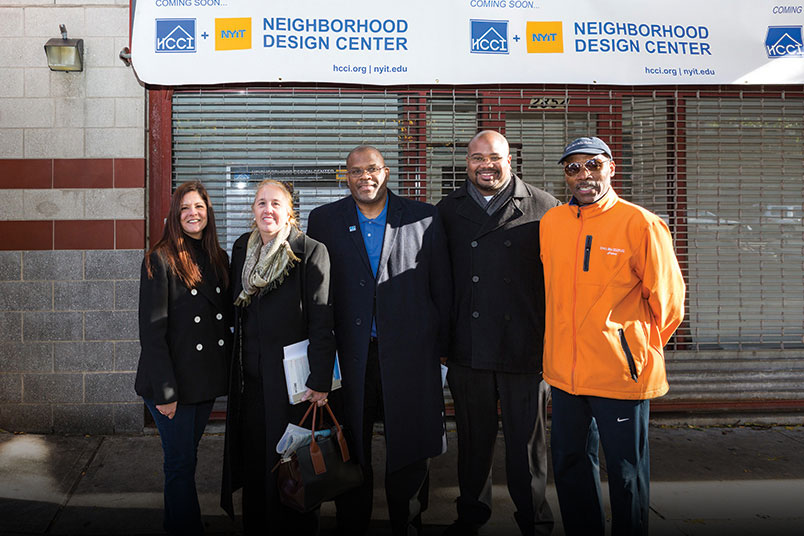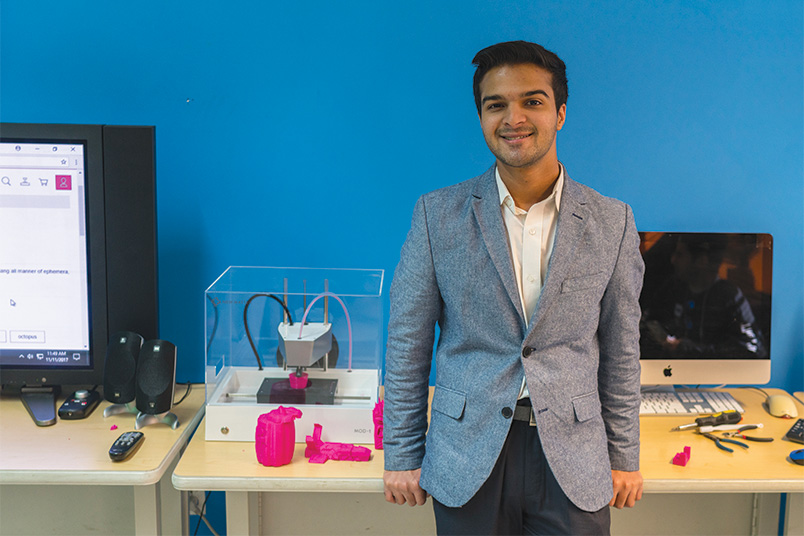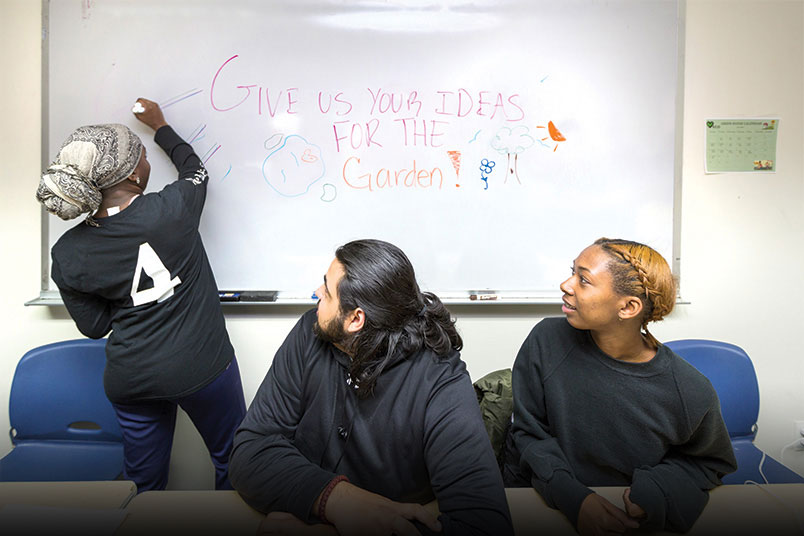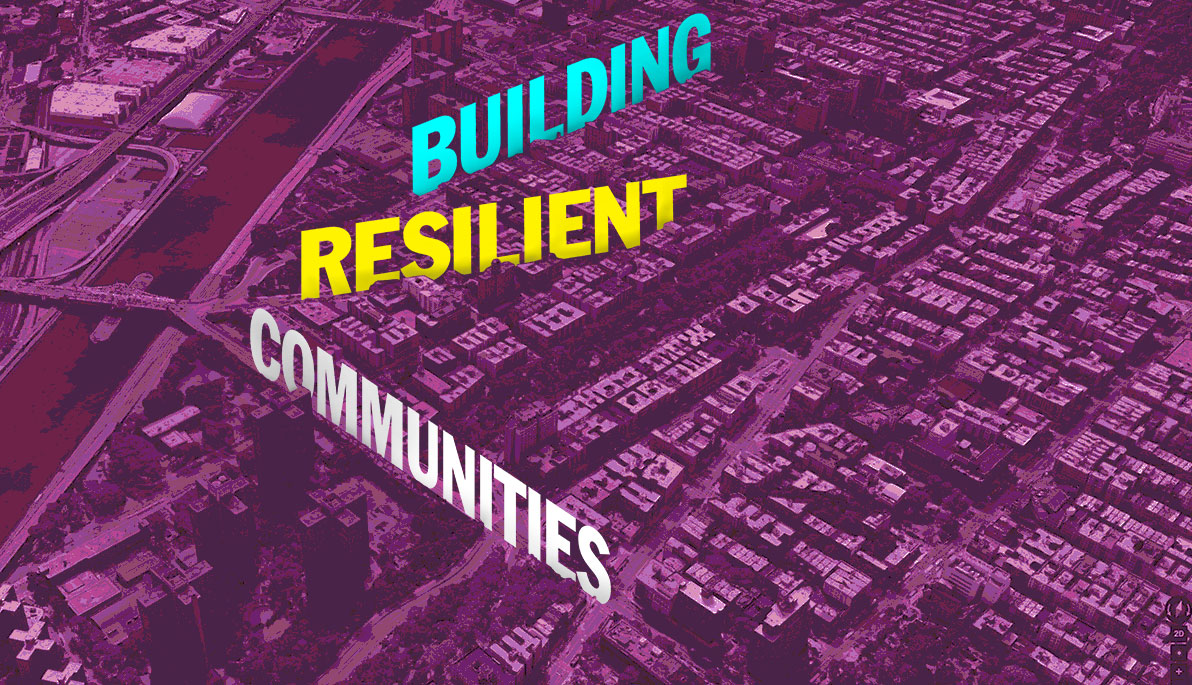
Building Resilient Communities
April 17, 2018
Building Resilient Communities features four major components:
- After-school programs that highlight STEM-based learning.
- A community-led Neighborhood Design Center focused on urban housing.
- A Parent University program to help families with the college application and enrollment process.
- A community healthcare program.
A new initiative between NYIT and Harlem Congregations for Community Improvement (HCCI) encourages collaboration and programming that benefits Harlem’s Bradhurst community and NYIT students.
Inside 263 W. 153rd St. in Manhattan on a frigid Saturday in November, first-year NYIT student Aliyah Pimento was trying to stand out in the crowd. Armed with a soccer ball, a poster, and a big dose of enthusiasm, she pitched her idea for a new afterschool program, Fun With Fitness, to children, parents, and members of the local community. “There’s no competition involved. It’s just for fun,” she told visitors. By the end of the day, she had a sign-up sheet full of names.
Pimento was one of dozens of NYIT students and faculty and staff members—representing all of the university’s schools and colleges—who attended an open house for Building Resilient Communities. Launched in fall 2017, the initiative is the brainchild of NYIT Senior Director of International and Experiential Education Amy Bravo and Malcolm A. Punter, president and CEO of HCCI.
Established in 1986, HCCI is committed to the redevelopment of the Harlem community. “HCCI fosters resilience by creating affordable housing and employment opportunities, but they wanted to increase their community outreach,” says Bravo. “NYIT’s involvement will add components of science, technology, and sustainability that will have an impact on multiple generations in fun and productive ways.” To accomplish that, the two organizations developed an ambitious five-year plan that will benefit NYIT students and strengthen a blossoming corridor in Harlem: 150th Street, between Bradhurst Avenue and Macombs Place, to 162nd Street along Frederick Douglass Boulevard. The community has designated the area as a safe space for all. “[Bradhurst] was dark in the daytime,” said Rev. Al Taylor, New York State assemblyman, at the open house. “Now it’s the place everyone wants to be. And if our kids are going to be stakeholders and remain in this community, they need the education and the tools to get to the next level.”
Want to get involved? Contact:abravo@nyit.edu
That’s where students like Pimento come in. With the support of NYIT, HCCI, and other nonprofits, volunteers are developing programming that addresses key concerns, such as sustainability and wellness. “Our hope is that we come up with great, innovative ideas that will make our communities better places for all of us,” says Bravo.
STEM and the Seeds of Learning
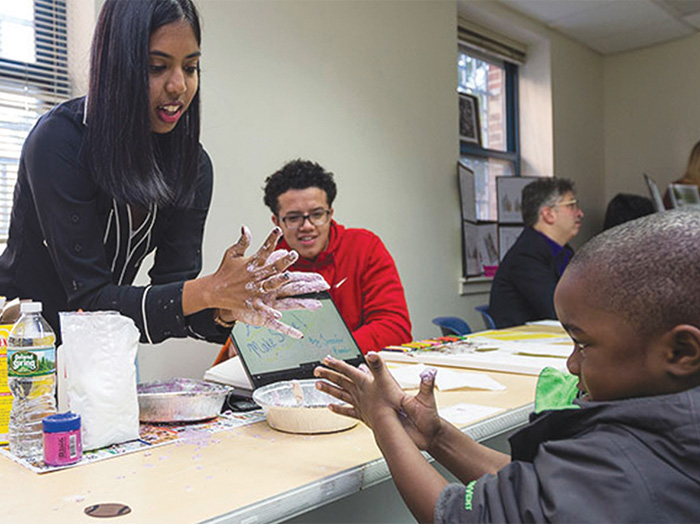
A student shows an open house attendee how to make slime.
Make your own slime. Dig in the dirt. Play with blocks. Sounds like fun, right? But all three activities also tie to STEM concepts like chemistry, biology, and engineering. In September, Building Resilient Communities officially kicked off with NYIT students delivering after-school enrichment programs for children. In addition to providing kids with a safe space, the programs integrate STEM-based learning. “These innovative programs will help young people get engaged with the latest technology,” says Punter. “These programs will help them become more marketable and have access to the greater educational community—a community that we have traditionally been cut off from in Harlem because of lack of access and lack of key partnerships.”
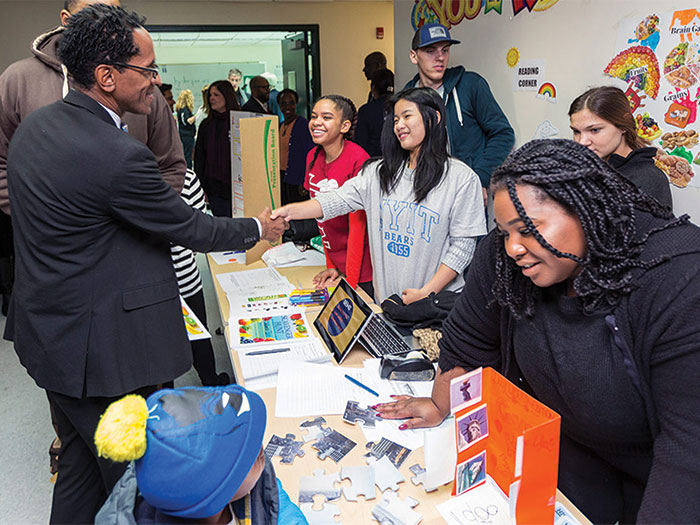
Students greet visitors, including the Rev. Al Taylor, and present ideas for programs at the open house.
The “clubhouse,” one of HCCI’s spaces in 263 W. 153rd St., is where the activities take place. Originally designed by MIT, it is being re-envisioned as a maker space and is stocked with computers, 3-D printers, and even a green screen. After-school leaders use these resources to help participants build technology and communication skills and inspire their imaginations. Second-year NYIT student Muhammad Tanveer organized some of this fall’s after-school programs in partnership with startup Hands That Make a Difference. “NYIT students are able to apply lessons they are introduced to in their service learning classes, like gathering anecdotal data and applying critical thinking and problem-solving skills,” says Tanveer. “From my own experience, the best way to learn something is to teach it to another student.”
We want our students to end up in jobs they like, but we also want them to learn that they have rights and responsibilities as community members.
Amy Bravo
Service learning is a big component of the first- and second-year student experience at NYIT, and many of the students volunteering with Building Resilient Communities are doing so as part of their Foundations of Inquiry and Foundations of Scientific Process coursework. Jim Martinez, Ph.D., associate professor in the School of Interdisciplinary Studies and Education and a mentor to the students running the program, says that being able to apply concepts discussed in the classroom is essential to the learning process. “Part of my job as an instructor is to give students time to reflect on what happened. I’ll ask them, ‘What did you notice? Who was there? Tell me in detail,’” he says. “That’s where the inquiry part of Foundations of Inquiry comes in.”
Parents and Students Learning Together
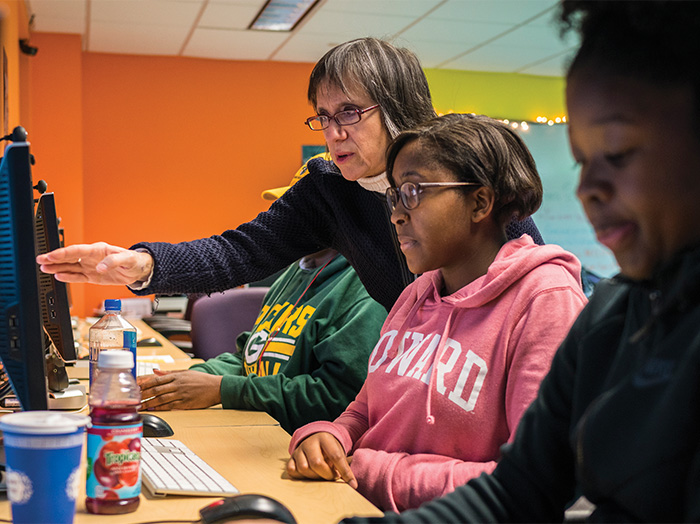
Participants in Parent University.
While young children are just beginning their academic journey, high school juniors and seniors have another challenge: getting into college. Parents must also navigate a gauntlet of financial aid forms and admission packets—a process that becomes even harder when a parent doesn’t speak English as a first language or has never experienced the process before. It’s a problem many members of the Bradhurst community face. The Building Resilient Communities team found a solution in Parent University—an initiative that helps keep families engaged in their children’s learning. “NYIT’s Parent University program is unique in that it focuses on helping parents and their children through the university admissions process,” says Emily Rukobo, executive director of NYIT’s Global Engagement office.
Joining Rukobo to oversee the program are Jennifer Rubin, administrative assistant in the Office of Global Engagement and a Parent University instructor, and Gwen Lowenheim, NYIT adjunct and Parent University instructor. “I have found teaching this class really eye-opening,” says Rubin. “These parents are hardworking, present, and engaged, and this program gives them a chance to voice their concerns.”
Programs like Parent University also have the potential to impact generations to come. “The future belongs to those who are prepared for it,” remarked HCCI Board Chairman the Rev. Dr. Charles A. Curtis at the open house. “People who participate in [Building Resilient Communities] will not only affect their own future, but their children’s future as well.”
The Road to Wellness
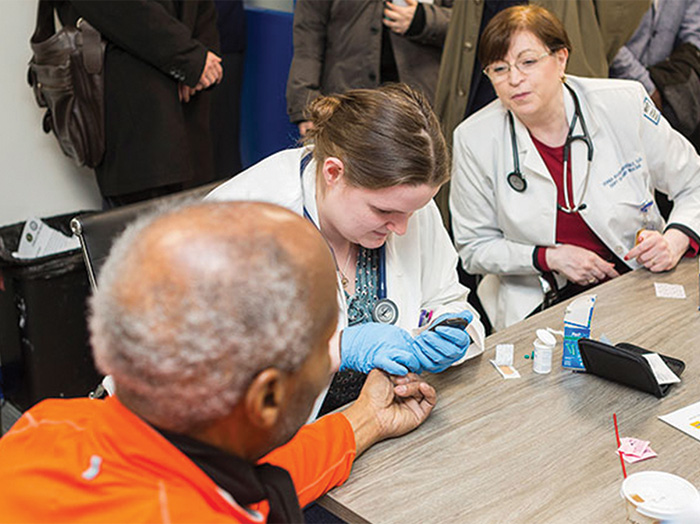
Associate Professor Sonia Rivera-Martinez, D.O., looks on as Bill Perkins, New York City Council, District 9 (left), volunteers for a wellness screening.
Building Resilient Communities wants to make a positive impact on the lives of everyone involved. The community healthcare program, another of the initiative’s four core components, is planning to offer free monthly screenings by faculty members and students in NYIT College of Osteopathic Medicine (NYITCOM) and NYIT School of Health Professions. “Research shows that students learn better when they use whatever they’ve learned in practice,” says Lillian Niwagaba, Ph.D., director of NYIT’s Center for Global Health and one of the faculty members leading the initiative. “Programs like this help us make sure our students get the practical skills needed for the 21st century.” In addition to wellness screenings, the team will also lead education sessions that align with the World Health Organization’s calendar and focus on a different health issue each month. Special attention will be paid to medical issues that are prevalent in the Harlem community, such as diabetes and high blood pressure. “Community engagement is a big part of medical training for our students,” explains Niwagaba. “As an osteopathic school, our students approach patient care in a holistic manner, focusing on the person, not just the disease. With Osteopathic Manipulation, students also use their hands to diagnose and treat instead of costly equipment, and they can make referrals to local clinics and hospitals where necessary.”
Future-Focused Community Spaces
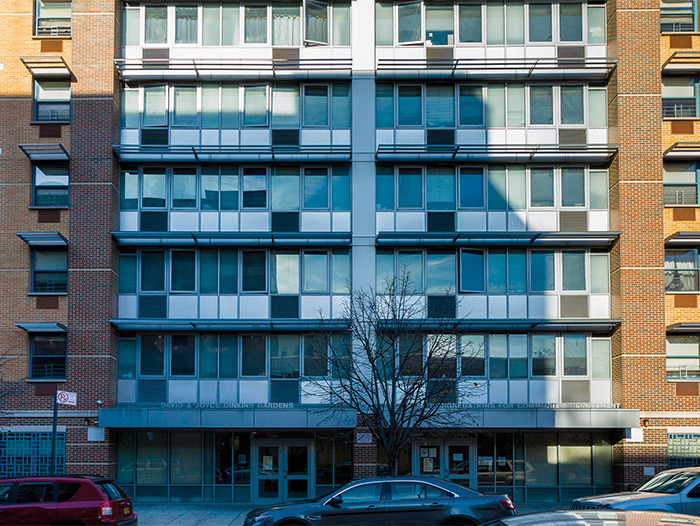
The facade of 263 W. 153rd St. (the first LEED-certified building for affordable housing in New York City).
HCCI approaches affordable housing and community development in a future-focused way. The first LEED-certified building for affordable housing in New York City was 263 W. 153rd St. It boasts a green roof, back garden, and now an indoor hydroponic garden.
Associate Professor Kate O’Hara oversees the hydroponics system. “Our vision is to reframe the narrative around what you can do in urban spaces,” she says. “Hydroponics is a term that may not seem relatable to people living in the city, but when you hear people say, ‘I have a small windowsill garden,’ or ‘I have a planter in my home,’ then the connection can be made that they can do the same thing, maybe even on a larger scale, by growing in sand or gravel, or in water—without any soil at all.” In October, children in the after-school program planted cilantro, sweet basil, butter lettuce, collard greens, and red Russian kale. Over the next six weeks, they cared for the seedlings, monitored their nutrition and growth, and learned about hydroponic gardening and sustainability. “We had a bumper crop!” adds O’Hara. She also has her sights on the green roof, which she and Bravo hope to transform and make accessible.
While a rooftop garden would be a boon for the building and its residents, Building Resilient Communities plans to address larger issues surrounding affordable housing. On Frederick Douglass Boulevard, construction is underway on a community-led Neighborhood Design Center. Helmed by Nicholas Bloom, Ph.D., associate professor and chair of Interdisciplinary Studies and Urban Administration, and Matthias Altwicker, associate dean of academics in the School of Architecture and Design, the design center will serve as a “housing think tank” where urban planners, architects, and community members can host programming about one of the city’s biggest challenges.
“Right now, housing development is very top down,” says Bloom. “Federal agencies and big architecture firms come up with ideas and then go out and try to sell them. We want to get a community-driven visioning process for housing because it’s the people who live in these neighborhoods and communities who are familiar with the real needs.”
A Not-So-Secret Garden
A few blocks south of the Neighborhood Design Center on West 148th Street, a neglected park is about to get a makeover. NYIT School of Architecture and Design students are reimagining the space so that it better serves the community’s needs and reflects the vibrant, growing neighborhood that surrounds it.
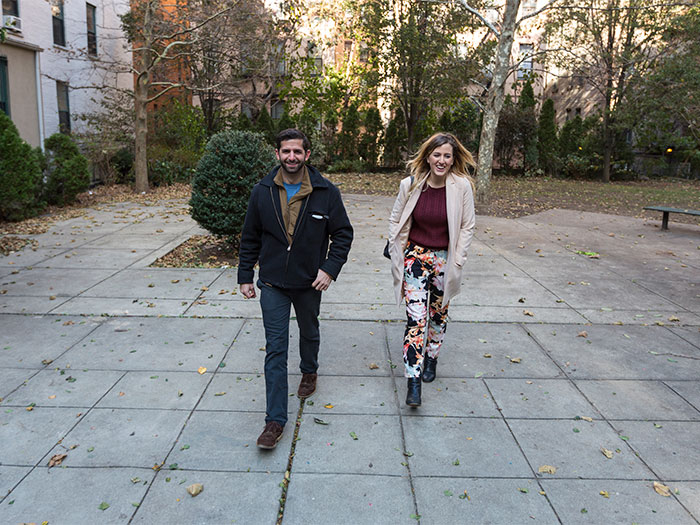
Michael Riccardi and Gabrielle Redding tour the park being re-envisioned by Freedom by Design. The top student-generated designs, which are being developed using feedback and data from public meetings, will be presented to community members, who will choose a winner.
Heading up the project is Freedom by Design—an NYIT student organization that produces a design project each year in collaboration with a local community organization. During the fall, the team hosted design charettes and public events to gather feedback from community members about their vision for the space. “One of the popular, recurring concepts from the community is to keep the park open and ready for events, allowing them to use it for gatherings and birthday parties,” says architecture student and project manager Gabrielle Redding. Fifth-year architecture student Michael Riccardi acknowledges it can be challenging to meet everyone’s requirements. “But it’s all about engaging with the community and hearing what they want,” he says. “Finding the best route to make the most people happy can be really rewarding.”
Programs That Innovate and Motivate
Though Building Resilient Communities is still in its early stages, the initiative is striking a chord with the NYIT and Bradhurst communities alike. Speaking at the open house, a community member said the program was a great opportunity to motivate her granddaughter and to teach her that “as a young woman she can be anything she wants to be.” According to Bravo, the collaboration has the potential to significantly impact NYIT’s future as well. “We want our students to end up in jobs they like, but we also want them to learn that they have rights and responsibilities as community members.” And service learning doesn’t end with a diploma. Nearly 200 NYIT alumni live or work in the area, and Bravo is already thinking of ways to get the wider NYIT community involved. She’s planning a meet-up for the spring with the hope of engaging alumni in the project and deepening NYIT’s roots in the community.
“NYIT has a reputation for producing great ideas, engaged citizens, and solutions for the community,” says Bravo. “If we can do that in five years here, then we can replicate it in other places. There’s no limit to the positive impact we can make.”
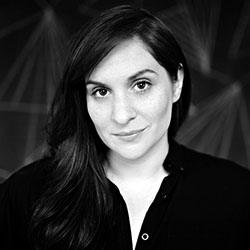
By Alix Sobler
More Features

An Alumnus’ Commitment to the Environment
As an energy management graduate from New York Tech’s Vancouver campus, Jasdeep Gulati (M.S. ’22) is highly invested in educating people about environmental and climate sustainability.

Vancouver Faculty Win University-Sponsored Research Awards in New Program
The new Global Impact Research Grant (GIRG) program has been developed to keep Vancouver-based faculty connected to faculty and research projects being conducted on the university’s New York campuses.

Studying Climate Change One Degree at a Time
Junhua Qu (M.S. ’24) began her collegiate journey in Beijing. But, her interest in climate change took her to New York Tech’s Vancouver campus to study energy management.
